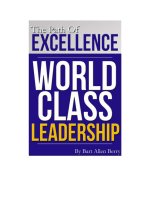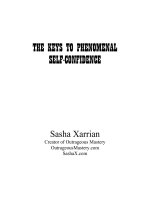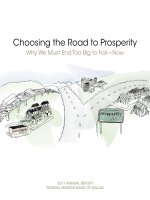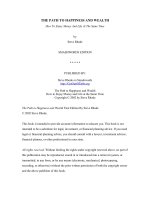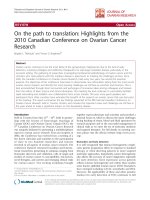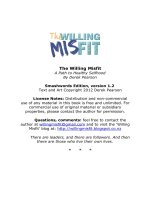Tanzania the path to prosperity
Bạn đang xem bản rút gọn của tài liệu. Xem và tải ngay bản đầy đủ của tài liệu tại đây (2.04 MB, 330 trang )
Tanzania
Africa: Policies For Prosperity Series
Series Editors
Christopher S. Adam and Paul Collier
For the first time in more than a generation, sustained economic growth has
been achieved across Africa—despite the downturn in global economic
fortunes since 2008—and in many countries these gains have been realized
through policy reforms driven by the decisive leadership of a new generation of
economic policy makers. The process of reform is continuous, however, and
the challenge currently facing this new generation is how to harness these
favourable gains in macroeconomic stability and turn them into a coherent
strategy for sustainable growth and poverty reduction over the coming
decades. These challenges are substantial and encompass the broad remit of
economic policy. Each volume in this series brings leading scholars into the
policy arena to examine, in a rigorous but accessible manner, the key economic
challenges and policy options facing policy makers on the continent.
BOOKS PUBLISHED IN THIS SERIES
Kenya: Policies for Prosperity
Edited by Christopher S. Adam, Paul Collier, and Njuguna Ndung’u
Zambia: Building Prosperity from Resource Wealth
Edited by Christopher S. Adam, Paul Collier, and Michael Gondwe
Tanzania: The Path to Prosperity
Edited by Christopher S. Adam, Paul Collier, and Benno Ndulu
Tanzania
The Path to Prosperity
Edited by Christopher S. Adam, Paul Collier,
and Benno Ndulu
1
3
Great Clarendon Street, Oxford, OX2 6DP,
United Kingdom
Oxford University Press is a department of the University of Oxford.
It furthers the University’s objective of excellence in research, scholarship,
and education by publishing worldwide. Oxford is a registered trade mark of
Oxford University Press in the UK and in certain other countries
© the various contributors 2017
The moral rights of the authors have been asserted
First Edition published in 2017
Impression: 1
All rights reserved. No part of this publication may be reproduced, stored in
a retrieval system, or transmitted, in any form or by any means, without the
prior permission in writing of Oxford University Press, or as expressly permitted
by law, by licence or under terms agreed with the appropriate reprographics
rights organization. Enquiries concerning reproduction outside the scope of the
above should be sent to the Rights Department, Oxford University Press, at the
address above
You must not circulate this work in any other form
and you must impose this same condition on any acquirer
Published in the United States of America by Oxford University Press
198 Madison Avenue, New York, NY 10016, United States of America
British Library Cataloguing in Publication Data
Data available
Library of Congress Control Number: 2016941486
ISBN 978–0–19–870481–2
Printed in Great Britain by
Clays Ltd, St Ives plc
Links to third party websites are provided by Oxford in good faith and
for information only. Oxford disclaims any responsibility for the materials
contained in any third party website referenced in this work.
Series Preface
Policies for Prosperity
Since the mid-1990s the economic prospects for Africa have been transformed.
The change has been uneven: some countries remain mired in conflict and
economic stagnation. But for many macroeconomic stability has been
achieved—even through the global financial crisis and its aftermath– and farreaching policy reforms have been put in place. For these countries, growth
prospects in the first quarter of the twenty-first century are much brighter than
at any time during the final quarter of the last century. But converting good
prospects into sustained growth and decisive poverty reduction requires a
degree of good luck, good policy formulation, resources, and a lot of good
economic management. For policy improvements to be sustained they must
be underpinned by more fundamental shifts in political power; sectional
interests ruling through patronage must be defeated by the public interest.
And for the shift in power to be decisive, the achievements of individual
reformers must be locked in through the development of effective institutions
in both the public and private sectors. The challenges are formidable: they
range beyond the conventional agenda of macroeconomic management,
infrastructure provision and the improvement of the investment climate. For
example, land policy, which has usually been left dormant, will need to be
rethought in the face of high population growth rates and rapid urbanization;
trade and industrial policies will need to be rethought so as to engage more
effectively with changing global opportunities; and the continent will need to
develop adaptive policies in the face of rapid climate change.
Many of the successes of recent decades have been wrought by the progressive leadership of a new generation of policy makers. To build on these
successes, this same generation needs both the support of, and restraint by,
an informed and engaged society. This is the fundamental philosophy of this
series: informed societies are strong societies. If citizens are to hold governments to account they require information, debate and dispassionate analysis
on the challenges and choices confronting countries and their people. This is
especially relevant in the realm of economic policy where path-dependency is
powerful and the consequences of choices are far-reaching and long-lasting.
Series Preface
In many industrialized economies there is a long tradition of informed debate
and analysis sustained in large measure by high-quality financial journalism. In
Africa, by contrast, while a dynamic and often fearless free press is now quite
widely established, it still lacks a tradition of solid, durable, and independent
writing on economic policy. As a result local debate is too often ill-informed or is
perceived to be driven by the agendas, and chequebooks, of sectional interests
and international organizations.
There is now considerable academic research on the issues that matter for
Africa and it could potentially inform Africa’s debates. But to date it has been
disconnected from them. Increasingly, academics write only for other academics rather than to inform the public. With this series of books we seek to
build bridges between the evidence from solid research and contemporary
policy debates. Each book aims to bring together the best international and
domestic scholars with policy makers working on economic policy issues
across the continent. Throughout, our contributors are required to write
with clarity, avoiding academic jargon, but equally avoiding advocacy. Focusing on the key issues that matter for a society, each chapter aims to leave
readers better able to draw their own conclusions about important choices.
vi
Acknowledgements
This book is the outcome of an active collaboration amongst a wide range of
scholars, officials and policy makers working on the economics of Tanzania.
Its origins lie in the close relationship forged over the last eight years between
the Governor and staff of the Bank of Tanzania and the International Growth
Centre (IGC). The IGC, of which two of us are members, is an international
research network partnership hosted by the London School of Economics and
the University of Oxford, and funded by the UK Department for International
Development. The IGC’s core objective is to promote sustainable growth in
developing countries by providing demand-led policy advice based on frontier
research. The Bank of Tanzania’s commitment to promoting researchinformed policy, both within its own domain and also across the whole of
the economic policy spectrum in Tanzania, has made it a natural partner for
the IGC and, indeed, many of the chapters in this book emerge directly from
work done under the aegis of the IGC and in close collaboration with the
Bank. We are particularly grateful to the Bank for hosting a highly productive
authors’ writing workshop in Stone Town, Zanzibar, in June 2015. We thank
the IGC in London for its financial support to the project and the current
and former staff of the IGC-Tanzania office in Dar es Salaam—Pantaleo
Kessy, Anne Laski, Joshua Chipman, Claire Lwehabura, Benjamin Langford,
Angela Ambroz, Ambassador Charles Mutalemwa, and our non-resident
Country Director, John Page—for their support and assistance as this project
has evolved.
As the Series Editors stress in their preface to this volume, the fundamental
idea underpinning the Policies for Prosperity series is that an informed society
is a strong society. This principle is central to the new dynamism in Tanzania
and it has been our privilege to have been able to draw so deeply on the
talent and insights from a wonderful set of authors based in the universities,
research groups, institutes, think-tanks, and official institutions in Tanzania.
We thank all these institutions for their commitment to the book. We also
extend a special note of thanks to the Honourable Minister for Finance and
Planning, Dr Philip Mpango, who was an important supporter of this project
during his time as Executive Secretary of the President’s Office Planning
Commission.
Acknowledgements
Our final thanks go to our colleague, Rose Page, for her superb work
behind the scenes in managing the process of turning our often chaotic
contributions into a volume of which we can all be proud. Rose has been our
managing editor since the inception of this series. It has been a great
pleasure working with her and, as with the previous volumes, her guidance,
support, and unfailing good humour has made our jobs as editors immeasurably easier.
viii
Contents
List of Figures
List of Tables
List of Boxes
List of Abbreviations
List of Contributors
1. Introduction: Productivity, Organizations, and Connectivity
Christopher S. Adam, Paul Collier, and Benno Ndulu
2. The Building Blocks towards Tanzania’s Prosperity: Lessons
from Looking Back, and the Way Forward
Benno Ndulu and Nkunde Mwase
xi
xv
xvii
xix
xxv
1
9
3. Managing Hydrocarbon Resources
Mark Henstridge and Dennis Rweyemamu
49
4. Transforming Dar es Salaam into a City That Works
Paul Collier and Patricia Jones
86
5. Trade, Logistics Infrastructure, and Regional Integration
Charles Kunaka, Olivier Hartmann, Gaël Raballand,
and Rukia Shamte
6. Agricultural Transformation in Tanzania: Linking Rural to
Urban through Domestic Value Chains
Douglas Gollin and Radhika Goyal
105
132
7. Unlocking Tanzania’s Manufacturing Potential
Margaret McMillan, John Page, and Samuel Wangwe
151
8. Building a Skills Agenda towards Productive Employment
Mahjabeen Haji and Jacques Morisset
170
9. Growth and Poverty: A Pragmatic Assessment and
Future Prospects
Channing Arndt, Vincent Leyaro, Kristin Mahrt, and Finn Tarp
190
Contents
10. Public Investment and Fiscal Reforms
Christopher S. Adam, Jehovaness Aikaeli, and Anne Laski
11. Monetary Policy in Tanzania: Accomplishments and the
Road Ahead
Pantaleo J. Kessy, Johnson Nyella, and Stephen A. O’Connell
214
241
12. Financial Sector Development and Financial Inclusion
Natu Mwamba, Nangi Massawe, and Kennedy Komba
271
Index
291
x
List of Figures
2.1.
Trends in commodity prices, 1960–2013
14
2.2.
Trends in global output, 1963–2014
14
2.3.
Trends in terms of trade, 1967–2013
15
2.4.
Trends in key output and production, 1960–2014
16
2.5.
Trends in export source markets, 1960–2014
25
2.6.
Trends in exports, 1960–2014
29
2.7.
Trends in imports, 1960–2014
29
3.1.
Asset transformation
51
3.2.
Natural gas in Tanzania
53
3.3.
Timeline for risk-free LNG
55
3.4.
Principal revenue streams from gas and LNG
60
3.5.
Revenue projections
62
3.6.
The authorizing environment for the transformation of a natural asset
67
3.7.
LNG in the balance of payments
70
3.8.
The sequencing of project impact on jobs
70
3.9.
Macroeconomic policy choices
76
3.10.
Scenario for borrowing in advance
77
3.11.
Scope for increased public sector pay
78
4.1.
Urbanization and economic development
87
4.2.
Urbanization in Tanzania and other countries
87
4.3.
Population density in Dar es Salaam, 2002 and 2012
90
4.4.
Means of transport to work
91
4.5.
Urbanization and industrialization
92
4.6.
Urbanization and industrialization in SSA
93
4.7.
Share of firms by sector
95
4.8.
Business local among informal enterprises
96
4.9.
Household sanitation in Dar es Salaam
97
Household water supply in Dar es Salaam
98
4.10.
List of Figures
4.11.
Map of the locations of the 20,000 plot areas
100
5.1.
Container throughput comparisons in 2012
107
5.2.
Share of Dar es Salaam in East Africa transit trade
108
5.3.
Traffic 2014 in Dar es Salaam—transit versus local cargo (million tons)
109
5.4.
Transit for petroleum products in 2014
109
5.5.
Transit for containers in 2014
109
5.6.
Evolution of transit and local containerized traffic in Dar es Salaam
110
5.7.
East Africa containerized trade and share of Dar es Salaam
111
5.8.
Transshipment traffic in the ports of Dar es Salaam and Mombasa
113
5.9.
LSCI for selected countries of the Western Indian Ocean coastline
114
5.10.
Crane productivity in Dar es Salaam, net moves per hour
115
5.11.
Berth occupancy and pre-berthing delays at the container berths
116
5.12.
Container dwell time in Dar es Salaam
118
5.13.
Evolution of the modal share rail–road in Tanzania
119
5.14.
Zambia trade volumes through Dar es Salaam Port
121
6.1.
Coffee production in Tanzania
136
6.2.
Urban population share in Tanzania
141
7.1.
Productive heterogeneity of small firms
161
8.1.
Tanzania employment categories
173
8.2.
Cross-country comparison of earnings per worker (2012)
174
8.3.
The predominance of self-employment and young firms
176
8.4.
Returns to education are low at lower levels (2010/11)
178
8.5.
Skills that are scarce in Tanzania (% firms)
180
8.6.
Distribution of training modes in the informal economy by sector
182
9.1.
Real crude oil prices
202
9.2.
Index of real prices received by farmers in the United States
203
10.1.
Tanzania debt dynamics
220
10.2.
Tanzania and the EAC big three
223
11.1.
Inflation and growth in Tanzania, 1984/85–2014/15
243
11.2a.
Targeted and actual real GDP growth in Tanzania, 1995/96–2014/15
246
11.2b.
Targeted and actual real CPI inflation in Tanzania, 1995/96–2014/15
247
11.3.
Fiscal-year reserve-money growth targets in Tanzania
248
11.4.
Relation of reserve money growth to nominal income growth
249
11.5.
Reserve-money targeting in Tanzania
252
11.6.
An interbank market with and without standing facilities
255
11.7.
Interest rates and monetary transmission in Tanzania
257
xii
List of Figures
11.8.
Volatility of monthly interest rates: Tanzania vs. nine other SSA
258
11.9.
Financial deepening: Tanzania vs. Other SSA
259
12.1.
Treasury bills market performance
277
12.2.
Access and usage of financial services in Tanzania, 2009–13
280
12.3.
Status of finance and investment protocol implementation
by country (using country-level commitments)
284
xiii
List of Tables
3.1.
Tanzanians employed in relation to Block 1, 3, and 4 during
exploration, 2012–13
56
3.2.
Summary of project and revenue projections
59
3.3.
Indicative estimates of direct labour demand by project phases
72
4.1.
Urbanization in Tanzania across time
88
4.2.
Firm productivity and city size
103
5.1.
Distance comparisons for DRC, Zambia, and Malawi
111
5.2.
Container freight rates in Dar es Salaam, 2010–12
111
5.3.
Aggregate delay between unloading from vessel and final delivery
to the client in Dar es Salaam Port, September–November 2008
117
5.4.
Possible advantages/costs of traffic in transit
120
5.5.
Estimate of total employment generated by trucking industry
126
6.1.
Long-term patterns of cereal yield
135
7.1.
Labour productivity growth in Tanzania, 2002–12
153
7.2.
Structure and growth of Tanzania’s economy (in constant prices)
154
7.3.
Benchmarking Tanzanian manufacturing
154
7.4.
Firms in the in-between sector by line of business
163
8.1.
Movement between employment sectors in Tanzania
176
9.1.
Households not deprived by welfare indicator (per cent)
195
9.2.
Households by number of deprivations in welfare indicators (per cent)
195
9.3.
Temporal net FOD comparisons, households (probabilities)
196
9.4.
2010 Bootstrap spatial FOD comparisons, households (probabilities)
197
9.5.
Spatial FOD ranking and probability of net domination by region
and year at household level
198
9.6.
Structure of the Tanzanian economy in 2007
205
9.7.
Indices of real-world prices (2007=100)
207
9.8.
Comparison of macroeconomic indicators for model and reported data
208
10.1.
Public investment, O&M and distortionary taxation
232
10.2.
Fiscal reforms
234
List of Tables
11.1.
11A.1.
Responses to deviations from the reserve-money ceiling
251
Aspects of the legislative mandate of the Bank of Tanzania
265
12.1.
The progress of selected financial market infrastructures in Tanzania
279
12.2.
Status of microfinance institutions in the country as of December 2014
281
xvi
List of Boxes
3.1.
Natural gas—terms and units
52
3.2.
Instruments for revenue from hydrocarbons
58
5.1.
A question of vocabulary—Transshipment hubs, logistics hubs,
and maritime gateways
110
5.2.
TICTS (Tanzania International Container Terminal Services)
114
List of Abbreviations
AICD
Africa Infrastructure Country Diagnostic
ASDP
Agricultural Sector Development Programme
ASIP
Annual Survey of Industrial Production
BAFIA
Banking and Financial Institutions Act
BIS
Basic Industrial Strategy
boe
barrels of oil equivalent
BoT
Bank of Tanzania
BRN
Big Results Now
BRT
Bus Rapid Transit
CAADP
Comprehensive Africa Agriculture Development Programme
CBD
central business district
CCBG
Committee of Central Bank Governors
CCTTFA
Central Corridor Transit Transport Facilitation Agency
CGE
computable general equilibrium
CGIAR
Consultative Group for International Agricultural Research
CIT
corporate income tax
CMSA
Capital Markets and Securities Authority
CNG
Compressed Natural Gas
COMESA
Common Market in East and Southern Africa
CPI
consumer price index
CRDB
Cooperative and Rural Development Bank
CSD
Central Depository System
DAC
Development Assistance Committee
DHS
Demographic and Health Surveys
DMO
Domestic Market Obligations
EAC
East African Community
EACB
East African Currency Board
EACSCO
East African Common Services Organization
List of Abbreviations
EAMU
East African Monetary Union
EFT
Electronic Fund Transfer
EPIC
Energy Policy Institute of Chicago
EPZA
Export Processing Zones Authority
ERP
Economic Recovery Plan
ESAAMLG
Eastern and South Africa Anti-Money Laundering Group
EWURA
Energy and Water Utility Regulatory Authority
FAOSTAT
Food and Agriculture Organization of the United Nations Statistics
Division
FBS
Food Balance Sheets
FDI
foreign direct investment
FEED
Front-End Engineering and Design
FID
Final Investment Decision
FOD
first order dominance
FSAP
Financial Sector Assessment Program
FYDP
Five-year Development Plan
GDP
gross domestic product
GIIP
gas initially in place
GIZ
Deutsche Gesellschaft für Internationale Zusammenarbeit
GSS
Government Securities System
HBS
Household Budget Survey
HDI
human development index
HGA
Host Government Agreement
HFP
Housing Finance Project
HIPC
Heavily Indebted Poor Countries
HIV
Human Immunodeficiency Virus
ICDs
inland container depots
ICT
Information and communications technology
IGC
International Growth Centre
IIDS
Integrated Industrial Development Strategy
IIR
institutional investor ratings
ILFS
Integrated Labor Force Survey
ILO
International Labour Organization
IT
inflation-targeting
IMF
International Monetary Fund
KK
Kilimo Kwanza
xx
List of Abbreviations
LMIC
lower middle income country
LNG
Liquified Natural Gas
LPG
Liquefied Petroleum Gas
LPI
Logistics Performance Index
LSCI
Liner Shipping Connectivity Index
LTPP
Long-Term Perspective Plan
MAC
Monetary Affairs Committee
MCF
marginal costs of funds
MDGs
Millennium Development Goals
MDRI
Multilaterial Debt Relief Initiative
MEM
Ministry of Energy and Minerals
MKUKUTA
National Strategy for Growth and Poverty
MLSC
Measuring Living Standards within Cities Survey
mmbtu
million British thermal units
MMT
millions of tonnes
MOF
Ministry of Finance
MSME
Micro, Small, and Medium Enterprise
MTEF
Medium-Term Expenditure Framework
MSC
Mediterranean Shipping Company
mscuf/d
millions of standard cubic feet per day
NACTE
National Council for Technical Education
NBC
National Bank of Commerce
NDC
National Development Corporation
NEDF
National Entrepreneurs Development Fund
NEMC
National Environment Management Council
NEPAD
New Partnership for Africa’s Development
NGOs
non-governmental organizations
NHC
National Housing Corporation
NMB
National Microfinance Bank
NOC
National Oil Company
NSSF
National Social Security Fund
NTB
non-tariff barrier
ODA
Official Development Assistance
ODCYs
off-dock container yards
OECD
Organisation for Economic Co-operation and Development
O&M
operations and maintenance
xxi
List of Abbreviations
PAYE
pay-as-you-earn
PEPA
Petroleum (Exploration and Production) Act
PMAESA
Port Management Association of Eastern and Southern Africa
POPC
President’s Office Planning Commission
PPP
purchasing power parity
PRSPs
poverty reduction strategy papers
PSA
production sharing agreement
PURA
Petroleum Upstream Regulatory Authority
RECs
Regional Economic Communities
RTG
rubber tyre gantry cranes
SACCOS
Savings and Credit Cooperative Societies
SADC
Southern Africa Development Community
SAGCOT
Southern Agricultural Growth Corridor of Tanzania
SAP
Structural Adjustment Programme
SELF
Small Entrepreneurs Loan Facility
SEZs
special economic zones
SIDO
Small Industries Development Organisation
SIDP
Sustainable Industrial Development Policy for Tanzania
SIRESS
Southern African Development Community Integrated Regional
Settlement System
SME
small–medium enterprise
SMEDP
Small and Medium Enterprise Development Policy
SSA
sub-Saharan Africa
SSRA
Social Security Regulator Authority
STS
ship-to-shore
SWIFT
Society for Worldwide Interbank Financial Telecommunication
TAFSIP
Tanzania Agriculture and Food Security Investment Plan
TASAF
Tanzania Social Action Fund
TCF
trillion cubic feet
TDHS
Tanzania Demographic and Health Surveys
TEUs
twenty-foot equivalent units
TFP
total factor productivity
TICTS
Tanzania International Container Terminal Services
TIRA
Tanzania Insurance Regulatory Authority
TISS
Tanzania Interbank Settlement System
TMRC
Tanzania Mortgage Refinancing Company
xxii
List of Abbreviations
TNBC
Tanzania National Business Council
TPA
Tanzania Ports Authority
TPDC
Tanzania Petroleum Development Corporation
TRA
Tanzania Revenue Authority
UN COMTRADE United Nations Commodity Trade Statistics Database
UNU-WIDER
United Nations University World Institute for Development
Economics Research
USAID
United States Agency for International Development
VETA
Vocational Education and Training Authority
VICOBA
Village Community Banks
VPO
Vice President’s Office
VSLA
Village Savings and Loans Association
VSO
Voluntary Service Overseas
WAY
weighted average yield
WDI
World Development Indicators
WHC
Watumishi Housing Company
xxiii
